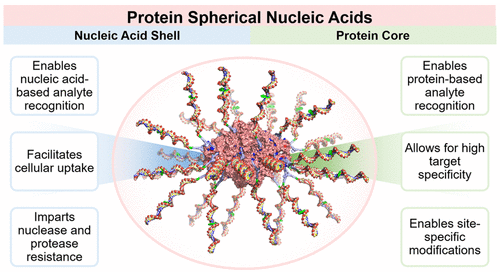FIT-Flares for Detection of Intracellular Analytes in Live Cells
NU 2020-044
INVENTORS
- Chad Mirkin*
- Sasha Ebrahimi
- Devleena Samanta
- Ho Fung Cheng
SHORT DESCRIPTION
A new class of signaling aptamers which contain a single modification, yet can be used to detect a broad range of targets
ABSTRACT
Aptamers are oligonucleotide sequences that can be evolved to bind to various analytes of interest. Northwestern researchers have developed a general design strategy that transduces an aptamer-target binding event into a fluorescence readout via the use of a viscosity-sensitive dye. Target binding to the aptamer leads to forced intercalation (FIT) of the dye between oligonucleotide base pairs, increasing its fluorescence by up to 20-fold. The application of this technology is particularly useful in challenging scenarios where studying analytes in living cells and complex media with high sensitivity and specificity remains difficult. Fluorescence-based methods offer advantages like simplicity, low-cost, high-throughput, and ability to multiplex. They demonstrate that FIT-aptamers can report target presence through intramolecular conformational changes, sandwich assays, as well as target-templated reassociation of split-aptamers, showing that the most common aptamer-target binding modes can be coupled to a FIT-based readout. Further, this strategy also can be used to detect the formation of a metallo-base pair within a duplexed strand and is therefore attractive for screening for metal-mediated base pairing events. The strategy can also be used to deliver different molecules, via functionalization of nanoparticles, for diagnostic and theranostic purposes in vitro. Taken together, FIT-aptamers are a new class of signaling aptamers which contain a single modification, yet detect a broad range of targets.
APPLICATIONS
- Report target presence through intramolecular conformational changes, sandwich assays, and target-templated reassociation of split-aptamers in cells and complex media
- Detects and images analytes
- Quantifies analyte levels
- Regulates and detects analytes for thernostic purposes
- Screening for metal-mediated base pairing events by detection of the formation of a metallo-base pair within a duplexed strand
ADVANTAGES
- Reduces false-positive signals typically associated with fluorophore-quencher based systems (No requirement of quencher)
- Quantitatively outperforms FRET-based probes by providing up to 15-fold higher signal to background ratios and superior readout kinetics
- Allows rapid and highly sensitive target detection (nanomolar range) in complex media such as human serum with low signal to noise ratios
- Enables delivery of detection elements in live cells without transfection agents
- Requires only a single modification in its target of interest to fluoresce
PUBLICATIONS
- Ebrahimi S. B., Smanta D, Cheng H. F., Nathan L, and Mirkin C. A. (2019) Forced Intercalation (FIT) Aptamers. Journal of American Chemical Society. 141: 13744-48.
- Smanta D, Ebrahimi S. B., Kusmierz C. D., Cheng H. F., and Mirkin C. A. (2020) Protein Spherical Nucleic Acids. Journal of American Chemical Society. 142, 31,: 13350-13355
IP STATUS.png)
U.S. and Europe nationalization has been filed.
Patent Information:
| Title |
App Type |
Country |
Serial No. |
Patent No. |
File Date |
Issued Date |
Expire Date |
Categories:
Life Sciences > Biomarkers & Biomedical Research Tools
Keywords:
Biomedical
Diagnostics
Nanoparticle
Research tool
Sensors